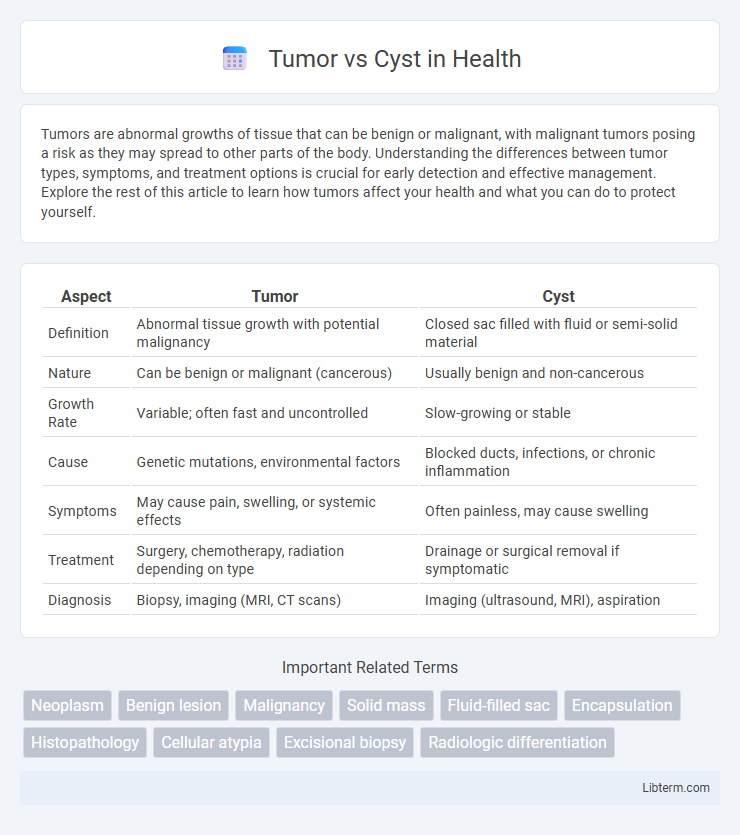Tumors are abnormal growths of tissue that can be benign or malignant, with malignant tumors posing a risk as they may spread to other parts of the body. Understanding the differences between tumor types, symptoms, and treatment options is crucial for early detection and effective management. Explore the rest of this article to learn how tumors affect your health and what you can do to protect yourself.
Table of Comparison
| Aspect | Tumor | Cyst |
|---|---|---|
| Definition | Abnormal tissue growth with potential malignancy | Closed sac filled with fluid or semi-solid material |
| Nature | Can be benign or malignant (cancerous) | Usually benign and non-cancerous |
| Growth Rate | Variable; often fast and uncontrolled | Slow-growing or stable |
| Cause | Genetic mutations, environmental factors | Blocked ducts, infections, or chronic inflammation |
| Symptoms | May cause pain, swelling, or systemic effects | Often painless, may cause swelling |
| Treatment | Surgery, chemotherapy, radiation depending on type | Drainage or surgical removal if symptomatic |
| Diagnosis | Biopsy, imaging (MRI, CT scans) | Imaging (ultrasound, MRI), aspiration |
Introduction to Tumors and Cysts
Tumors and cysts are abnormal growths that develop in various tissues of the body, each with distinct characteristics and implications. Tumors consist of proliferating cells that can be benign or malignant, impacting surrounding tissues with potential for cancerous behavior. Cysts are fluid-filled sacs typically benign, arising from blocked ducts or tissue defects, often posing less risk but requiring evaluation for size and impact.
Defining Tumors: Key Characteristics
Tumors are abnormal masses of tissue resulting from uncontrolled cell growth, which can be benign or malignant and often invade surrounding tissues. Unlike cysts, which are fluid-filled sacs, tumors consist of solid tissue masses that may disrupt normal organ function. Key characteristics of tumors include irregular shape, rapid cell proliferation, and potential to metastasize in the case of malignancy.
Understanding Cysts: Essential Features
Cysts are sac-like structures filled with fluid, semi-solid, or gaseous material, often benign and less aggressive than tumors. They typically develop due to blockages in ducts, infections, or chronic inflammation, presenting as smooth, well-defined masses on imaging studies. Unlike tumors, cysts usually do not invade surrounding tissues and can often be treated with minimally invasive procedures or monitored for changes over time.
Main Differences Between Tumors and Cysts
Tumors are abnormal masses of tissue that can be benign or malignant, while cysts are fluid-filled sacs typically harmless but sometimes problematic. Tumors grow by uncontrolled cell proliferation and may invade surrounding tissues, whereas cysts develop due to blockages of ducts or infections and usually remain localized. Imaging techniques such as MRI and ultrasound aid in distinguishing tumors from cysts based on their composition and growth patterns.
Causes and Risk Factors
Tumors and cysts each arise from distinct causes and risk factors influencing their development. Tumors result from abnormal cell growth due to genetic mutations, environmental exposures like carcinogens, and lifestyle factors such as smoking, which increase the risk of malignancy. Cysts form when glands, ducts, or tissues become blocked or injured, often caused by infections, chronic inflammation, or developmental abnormalities, with risk factors including hormonal imbalances and certain inherited disorders.
Symptoms and Clinical Presentation
Tumors often present with persistent pain, swelling, and localized masses that can be firm or irregular in shape, sometimes accompanied by weight loss or fatigue indicating systemic involvement. Cysts typically manifest as painless, fluid-filled sacs beneath the skin or within organs, causing swelling or discomfort only when infection or rupture occurs. Clinical presentation of tumors generally involves progressive growth and possible interference with organ function, whereas cysts usually remain stable or resolve spontaneously unless complicated.
Diagnostic Techniques and Imaging
Diagnostic techniques for distinguishing tumors from cysts primarily involve imaging modalities such as ultrasound, MRI, and CT scans, which provide detailed information about lesion characteristics. Ultrasound effectively identifies cystic structures by revealing fluid-filled spaces with well-defined borders, while tumors often appear as solid masses with irregular shapes and heterogeneous textures on MRI and CT images. Advanced imaging methods, including contrast-enhanced scans and diffusion-weighted MRI, enhance differentiation by highlighting vascularity and cellular density, critical for accurate diagnosis and treatment planning.
Treatment Options and Management
Tumors often require surgical removal, radiation therapy, or chemotherapy depending on their malignancy and location, while cysts are typically managed with observation, drainage, or surgical excision if symptomatic or growing. Benign tumors may only need monitoring, whereas malignant tumors necessitate aggressive treatment plans coordinated by oncology specialists. Cyst management prioritizes alleviating symptoms and preventing infection, with imaging guidance facilitating precise interventions.
Potential Complications and Outcomes
Tumors can lead to serious complications such as malignancy, invasion of surrounding tissues, metastasis, and organ dysfunction, which often require aggressive treatment like surgery, chemotherapy, or radiation. Cysts typically present fewer risks but may cause complications like infection, rupture, or compression of nearby structures, leading to pain or impaired function. Early diagnosis and appropriate management are crucial for preventing adverse outcomes and improving prognosis in both tumors and cysts.
When to Seek Medical Attention
Seek medical attention immediately if a lump grows rapidly, becomes painful, or causes functional impairment, as these signs may indicate a tumor rather than a benign cyst. Persistent lumps that do not resolve after several weeks, change in color or texture, or are accompanied by unexplained weight loss and fatigue require prompt evaluation. Early diagnosis through imaging and biopsy is crucial to differentiate between benign cysts and malignant tumors for effective treatment.
Tumor Infographic

 libterm.com
libterm.com